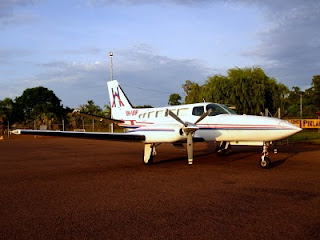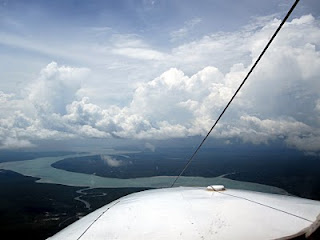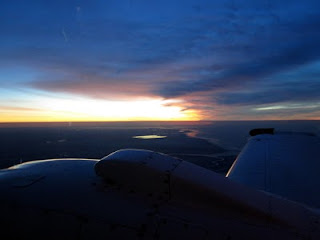I think thats how you spell it. I will just call it umk for the purpose of not writing its full name. Umk is one of the few strips i have been into, when i was flying singles that i stuck out as being dodgy, short and with crazy cross winds. Its right on the coast, on Groote Eylandt, roughly 40km north-east.
I remember the first time i went to the strip, was in a C206 with a whole bunch of computer equipment. It was during the dry season, and i have a horrible headwind the entire flight. Now the flight to Umk is 357nm. Couple this with about 2 months of solid baron flying, then going back into the slowest 206 on one of the longest flights, i was not a happy camper, as such. Anyway, i remember arriving at the strip and the wind was easily around 25-30 knots, all cross. Even though i have over a 100 hours on C206 aeroplanes, it felt foreign since i hadn't been flying it as recent, and it doesn't take long to lose your feel for it.
So we arrived and it was one of about 3 times in my flying career, where the only thing i was thinking was "this could go either way." Not a very good feeling! I remember as i landed with full aileron into wind, and full rudder i was still being dragged across the runway. Eventually i stopped and backtracked, uneventfully, but that was my first memory of that strip.
Fast forward to yesterday and the day before, im told im going to umk in a C402 with a lot of gear for a few blokes who are overnighting. So we departed just before first light and did the 357nm, reasonably slowly at 9000ft, and arrived at a very calm umk, no wind, and the strip looked and felt better than i remembered! So not to worry. Unloaded and was asked if i was picking them up tomorrow! Naturally i had no idea i would be, but as it turned out, i was doing the return charter.


Umk from the air and from the ground. These were taken at about 8:30am on the first day dropping the boys off.
Now the return charter was bumpy being in the afternoon with lots of build up happening. But none the less, arrived over Groote Eylandt and saw no less than 3 cells around the umk areas. It was rough while descending, and i even reduced power early to try give the least impact to my mid 70's built chariot. Did a solid circuit over the strip to make sure i knew where the wind was coming from and did an uneventful and windless landing?! Again, i was suprised, but all was good.
Now for when we finally departed, those little areas of buildup were now a solid line of storms. Every time i thought i found a gap, all i could see was huge amounts of lightning and more cells behind them. I think i ended up diverting 20nm to the north and eventually found a gap. Even though i had weather radar in this aircraft, i found it was actually easier and most likely safer to remain visual and go lower/find the gaps. Worked well, and after about 20 - 30min of storm dodging we were in reasonably clear air with just isolated cells around, but none on my track to Jabiru for my fuelling stop. I needed fuel, mainly due to the holding requirements back into Darwin, but i had also done a few extra stops on the way to umk, combining 2 charters into one, as i was empty over there, it made operational sense. One was to Bickerton Island, and the other to Ngukkur.

Line of cells i was dodging about 20 minutes into the cruise. I was tracking virtually north at this point for around 20nm to get around them.
So we eventually arrived at Jabiru, and although being a reasonable sized airstrip for Arnhem land, it has no lights, but the fuel there is a lot cheaper than elsewhere... when it works! Since it has no lights, and i landed at around 18:15, that gave me roughly 45 minutes till end of daylight for departure. Not a problem to put 300lbs of fuel on a 402. But as it turns out Jabiru had been hit by a massive storm about an hour earlier, which after a few calls found out had busted the bowser. Luckily i know a few of the boys that work for the local companies in Jabiru and was able to get one of them to come out and try reset the switches. Eventually it worked, and we were airbourne at around 18:55. Close! The last thing i wanted after such a big day of flying was to overnight in Jabiru!

Flying over Kakadu National Park at 6000ft on the way to Jabiru for fuel. The terrain in this area is around 2500ft.
Anyway, thats the story of yesterdays adventure. I'm going to write more about "how is this going to end" in a future post. I have some good stories, and weird occurances that have happened, mainly doing mailruns in central Australia. Most times it's been external factors, that was happened, but its crazy just how quick you can think and remember things when you have too. till next time, enjoy some of the photos!
I have also uploaded a video of me landing a C402B into Maningrida. Enjoy.
http://www.youtube.com/watch?v=gz1ibW3W_WM
On the back of a ute at Bickerton Island. Good times.

Numbalwar from the air! You can see the strip on the left hand side.


















































